介词by用法详解
第18讲 介词by的用法及其扩展-【暑假衔接】2021年新九年级英语暑假精品知识点(人教版)
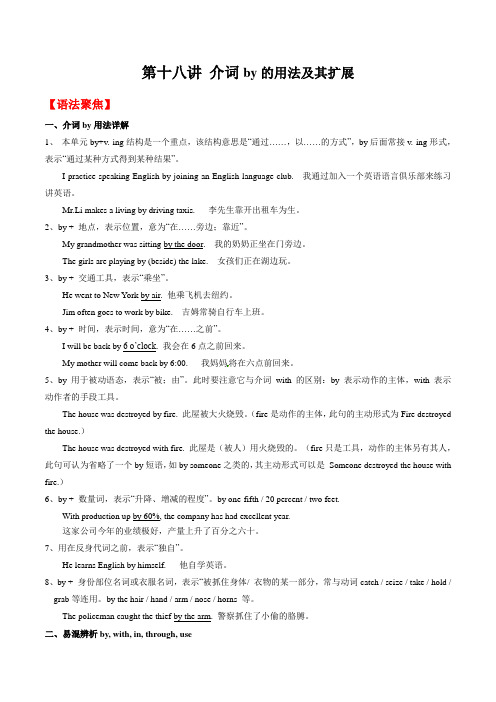
第十八讲介词by的用法及其扩展【语法聚焦】一、介词by用法详解1、本单元by+v.-ing结构是一个重点,该结构意思是“通过……,以……的方式”,by后面常接v.-ing形式,表示“通过某种方式得到某种结果”。
I practice speaking English by joining an English-language club. 我通过加入一个英语语言俱乐部来练习讲英语。
Mr.Li makes a living by driving taxis. 李先生靠开出租车为生。
2、by + 地点,表示位置,意为“在……旁边;靠近”。
My grandmother was sitting by the door. 我的奶奶正坐在门旁边。
The girls are playing by (beside) the lake. 女孩们正在湖边玩。
3、by + 交通工具,表示“乘坐”。
He went to New York by air. 他乘飞机去纽约。
Jim often goes to work by bike. 吉姆常骑自行车上班。
4、by + 时间,表示时间,意为“在……之前”。
I will be back by 6 o’clock. 我会在6点之前回来。
My mother will come back by 6:00. 我妈妈将在六点前回来。
5、by 用于被动语态,表示“被;由”。
此时要注意它与介词with的区别:by 表示动作的主体,with 表示动作者的手段工具。
The house was destroyed by fire. 此屋被大火烧毁。
(fire是动作的主体,此句的主动形式为Fire destroyed the house.)The house was destroyed with fire. 此屋是(被人)用火烧毁的。
(fire只是工具,动作的主体另有其人,此句可认为省略了一个by短语,如by someone之类的,其主动形式可以是Someone destroyed the house with fire.)6、by + 数量词,表示“升降、增减的程度”。
介词 of from for by at during behind用法注意

介词of 用法注意1.表示所有关系,用以构成名词的所有格,如the gate of the school(校门),the se cret of success(成功的秘密),等。
注意以下正误表达:正:He is a friend of my father. 他是我父亲的一位朋友。
正:He is a friend of my father’s. 他是我父亲的一位朋友。
正:He is a friend of mine. 他是我的一位朋友。
误:He is a friend of me.以下表达是错误的:误:What’s the name of you?(改为…your name)误:Do you know the father of him?(改为…his father)误:I will show the books of me.(改为…my books)但是以下表达却是对的(of表示动宾关系):正:I hate the sight of him. 我讨厌看到他。
正:His criticism of her is serious. 他对她的批评是严肃的。
2.与age, shape, size, colour, height, design, weight 等名词连用,可用作表语或定语;其中的介词of 有时可省略。
如:The two boys are (of) the same height. 这两个男孩一样高。
Here is a piece of wood (of) the right size. 这有一块木头,其大小刚好适合。
When I was (of) your age, I lived in the country. 我像你这个年纪的时候,我住在乡下。
3.与某些名词(如help, value, interest, importance等)连用,相当于形容词,可用作定语或表语。
如:It’s not of mu ch value. 这没有多大价值。
专题07 介词-2023年高中英语九大词性分类与用法详解
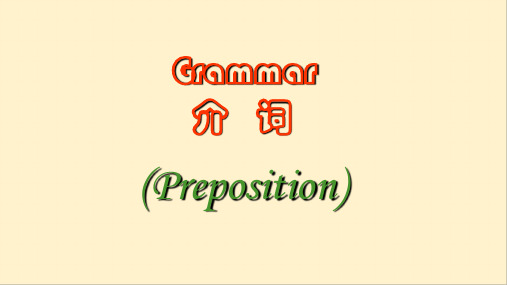
表示时间、地点、方式、条件、目的、原因等
Spielberg was born in the state of Ohio, America, in 1946.
(介词短语表时间和地点)
What can I do for you in return for your help?(介词短语表目的)
at six o’clock
at noon
at that time
At weekends在周末 At Christmas在圣诞期间
3)on表示特定的日子,具体的某一天的上午、下午或晚上
on New Year’s Day on Monday on May , 2020
2. in, on, to
这三个词都可用于表示两者之间的方位关系
in在…里面
near在附近
under在…下方
beyond在…以外 to往,通向
beneath在…底下 off从…离开
before在……之前 like像…… up在…上 against逆着,靠着
有些介词也可用作副词,如off, in, about等 Keep off the grass 请勿踩踏草坪。(off为介词) She took off her gloves.她摘掉了手套。(off为副词)
1)in表示在某范围之内
Grammar 介词
(Preposition)
介词综述
介词是一种虚词,本身不能单独使用或充当句 子成分,其后必须跟宾语。
介词与其宾语构成介词短语,在句中作状语、 表语、补语和定语。
一、介词的分类
1.根据介词的构成分类
1)简单介词:指的是由一个单词构成的介词
介词的用法总结大全
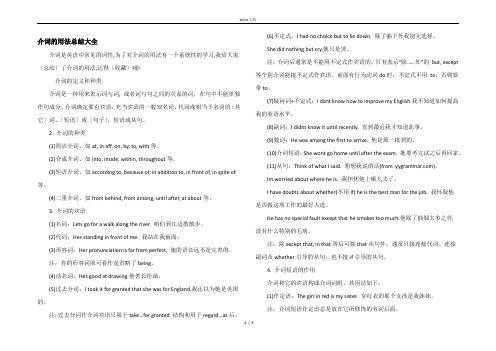
介词的用法总结大全介词是英语中常见的词性,为了对介词的用法有一个系统性的学习,我给大家〔总结〕了介词的用法,记得〔收藏〕哦!介词的定义和种类介词是一种用来表示词与词, 或者词与句之间的关系的词,在句中不能单独作句成分。
介词确定要有宾语,充当宾语的一般知名词、代词或相当于名词的〔其它〕词、〔短语〕或〔句子〕,短语或从句。
2. 介词的种类(1)简洁介词,如at, in off, on, by, to, with等。
(2)合成介词,如into, inside, within, throughout等。
(3)短语介词,如according to, because of, in addition to, in front of, in spite of 等。
(4)二重介词,如from behind, from among, until after, at about等。
3. 介词的宾语(1)名词:Lets go for a walk along the river. 咱们到江边散散步。
(2)代词:Hes standing in front of me. 我站在我前面。
(3)形容词:Her pronunciation is far from perfect. 她的语音远不是完善的。
注:有的形容词前可看作是省略了being。
(4)动名词:Hes good at drawing.他善长绘画。
(5)过去分词:I took it for granted that she was for England.我还以为她是英国的。
注:过去分词作介词宾语只限于take…for granted 结构和用于regard…as后。
(6)不定式:I had no choice but to lie down. 除了躺下外我别无选择。
She did nothing but cry.她只是哭。
注:介词后通常是不能用不定式作宾语的,只有表示“除……外”的but, except 等个别介词能接不定式作宾语。
by的用法

博学笃行自强不息
by的用法
By的用法
By是一个常见的英语词汇,在不同的语境下有不同的意思和用法。
它可以作为介词、副词、连词和一个非正式的缩略语。
在本文中,
我们将探讨By的不同用法,并给出一些例句来帮助大家更好地理解。
1. 作为介词:
作为介词,By用于表示通过某种手段或方式来实现某事。
它可以表示时间、方式、原因等。
以下是一些常见的用法:
- By means of(通过):
- We can solve this problem by means of technology.
(我们可以通过技术来解决这个问题。
)
- He escaped by means of a secret passage.
(他通过一个秘密通道逃脱了。
)
1。
小学英语语法详解介词--表手段、方式的介词

小学英语语法详解介词——一些常见的的介词及其用法3)表手段、方式的介词by,in,with等。
①by+交通工具,指的是所用的交通方式。
by boat by train坐火车by taxi坐出租车by bus坐公共汽车by bike骑自行车by boat坐船by plane坐飞机②inThey paid in cash.他们用现金支付。
Can I speak in Chinese?我可以用中文说吗?Please read it in a high voice.请响亮地朗读。
③withWith the eyes,I can see.我用眼睛看。
I cut the apple with a sharp knife.我用一把锋利的刀削苹果。
Tom drew the picture with a pencil.汤姆用铅笔画画。
4)小学阶段的一些常见的介词及其用法①ofa. (属于)….的He is a friend of mine.他是我的一个朋友。
b.由....组成(或构成)This is a cake of sugar.这是一块糖做的蛋糕。
C.含有(或装有)…. 的A packet of biscuits please.请给我一包饼干。
d.表示数量或种类The tiger eats ten kilos of meat every day.老虎每天要吃十公斤肉。
e.由于、因为She died of illness.她是病死的。
of的一些重要词组* because ofHe left because of his fail.他因失败而离开。
* be afraid ofI am afraid of spiders.我害怕蜘蛛。
* a lot ofThere is a lot of sunshine.阳光很好。
* all kinds ofThere are all kinds of fruits in the basket.篮子里有各种水果。
英语介词用法详解
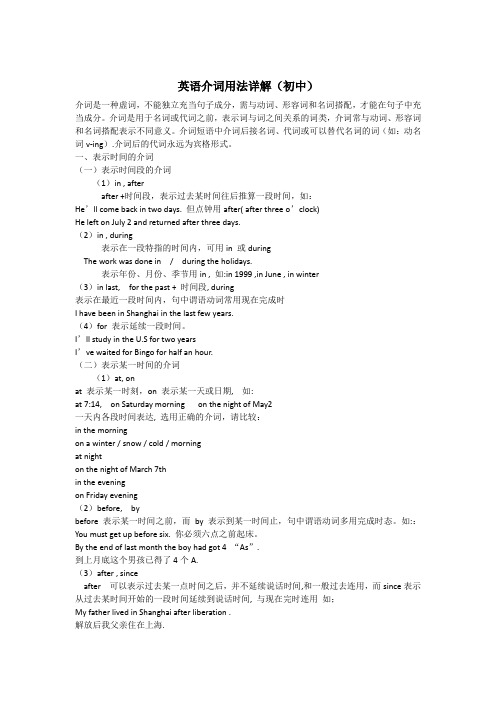
英语介词用法详解(初中)介词是一种虚词,不能独立充当句子成分,需与动词、形容词和名词搭配,才能在句子中充当成分。
介词是用于名词或代词之前,表示词与词之间关系的词类,介词常与动词、形容词和名词搭配表示不同意义。
介词短语中介词后接名词、代词或可以替代名词的词(如:动名词v-ing).介词后的代词永远为宾格形式。
一、表示时间的介词(一)表示时间段的介词(1)in , afterafter +时间段,表示过去某时间往后推算一段时间,如:He’ll come back in two days. 但点钟用after( after three o’clock)He left on July 2 and returned after three days.(2)in , during表示在一段特指的时间内,可用in 或duringThe work was done in / during the holidays.表示年份、月份、季节用in , 如:in 1999 ,in June , in winter(3)in last, for the past + 时间段, during表示在最近一段时间内,句中谓语动词常用现在完成时I have been in Shanghai in the last few years.(4)for 表示延续一段时间。
I’ll study in the U.S for two yearsI’ve waited for Bingo for half an hour.(二)表示某一时间的介词(1)at, onat 表示某一时刻,on 表示某一天或日期, 如:at 7:14, on Saturday morning on the night of May2一天内各段时间表达, 选用正确的介词,请比较:in the morningon a winter / snow / cold / morningat nighton the night of March 7thin the eveningon Friday evening(2)before, bybefore 表示某一时间之前,而by 表示到某一时间止,句中谓语动词多用完成时态。
人教版九年级英语Unit1知识点梳理及语法讲义(教师版)

九年级英语Unit 1知识点与语法精讲精练词汇梳理(一)完成单词梳理:名词:1. textbook教科书;课本 2. conversation交谈;谈话 3. pronunciation发音;读音4. sentence 句子5. expression表情;表达方式6. grammar语法7. pal朋友;伙伴8. physics 物理;物理学9. chemistry 化学10. pattern 模式;方式11. speed 速度12. partner 搭档;同伴13. ability 能力;才能14. brain 大脑15. attention 注意;关注16. knowledge 知识动词:1. discover 发现;发觉 2. repeat 重复 3. memorize 记忆;记住pronounce 发音 5. increase 增加;增长 6. create 创造;创建7. connect (使)连接;与……有联系形容词:1. active 活跃的;积极的 2. lifelong 终身的;毕生的副词:1. aloud 大声地;出声地 2. overnight 一夜之间;在夜间 3. wisely 明智地;聪明地兼类词:1. patient (adj)有耐心的(n)病人 2. secret (n)秘密;秘诀(adj)秘密的3. note (n)笔记;记录(v)注意;指出4. born (v)出生(adj)天生的5. review (v/n)回顾;复习(二) 词汇变形小结:1. pronounce (v. 发音) — pronunciation (n. 发音;读音)2. patient (adj. 有耐心的) — patience (n. 耐心) — patiently (adv. 耐心地)3.express (v.表达;表示) — expression (n. 表情;表达方式)4. discover (v.发现;发觉) — discovery (n.发现)5. secret (adj. 秘密的) — secretly (adv.秘密地)6. physics (n. 物理;物理学) — physical (adj. 物理的;身体的)7. chemistry (n. 化学) — chemical (adj. 化学的)8. memorize (v. 记忆;记住) — memory (n. 回忆)9. ability (n. 能力) — able (adj. 有能力的)10. create(v. 创造;创建) — creative (adj. 有创造力的) — creation (n. 创造力)11. connect(v. 与……有联系)— connection (n. 联系)12. knowledge(n. 知识)— knowledgeable (adj. 知识渊博的)13. wise(adj. 明智的)— wisely (adv. 明智地;聪明地)【练一练】用所给词的适当形式填空1.If you don’t spend money __wisely__ (wise),you may go broke.2.Reading English aloud will help you improve your __pronunciation__(pronounce).3.It is a good idea to help parents by doing (do) something.4.I think the_expressions__ (express) on his face are very strange.5.The discovery (discover) of the stone is very important.6.He was shy and wasn’t able (ability) to make friends quickly in school.7.Everyone is born with the ability to learn, but it’s hard to learn wisely (wise).(三) 短语攻关:look up 查阅;抬头看be born with 天生具有pay attention to 注意;关注connect…with…把……和……连接read aloud 大声朗读have a conversation with 与……交谈make a sentence造句be patient with sb/sth 对某人/某事有耐心be patient to do sth 有耐心做某事the secret to ……的秘诀take notes 记笔记practice doing sth 练习做某事ask sb for help 向某人寻求帮助give a report 作报告word by word 逐字逐句study for a test 备考speaking skills 口语技能spoken English 英语口语at first 起初;开始fall in love with 爱上keep a diary 写日记spoken English 英语口语learn from 向……学习find out 查明write down 写下;记下instead of 代替;而不是make mistakes 犯错误mind maps 思维导图知识点梳理1. by reading the textbook 通过阅读课本重点:by doing sth 通过做某事【用法详解】by作介词,意为“通过”,表示方式或方法。
介词in的详解和例题解析
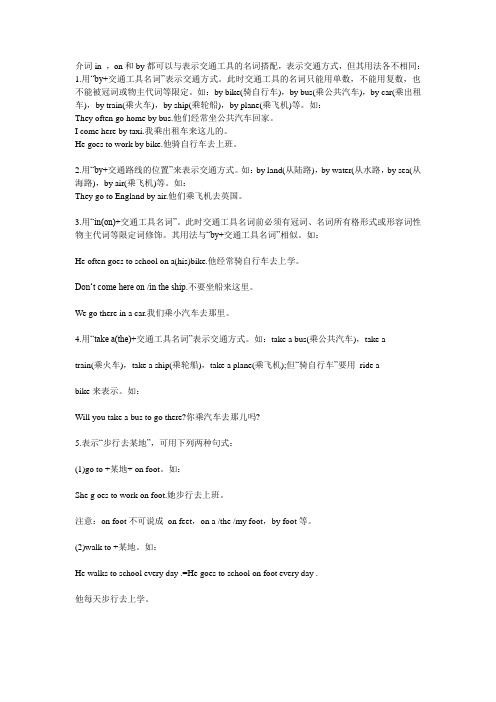
介词in ,on和by都可以与表示交通工具的名词搭配,表示交通方式,但其用法各不相同:1.用“by+交通工具名词”表示交通方式。
此时交通工具的名词只能用单数,不能用复数,也不能被冠词或物主代词等限定。
如:by bike(骑自行车),by bus(乘公共汽车),by car(乘出租车),by train(乘火车),by ship(乘轮船),by plane(乘飞机)等。
如:They often go home by bus.他们经常坐公共汽车回家。
I come here by taxi.我乘出租车来这儿的。
He goes to work by bike.他骑自行车去上班。
2.用“by+交通路线的位置”来表示交通方式。
如:by land(从陆路),by water(从水路,by sea(从海路),by air(乘飞机)等。
如:They go to England by air.他们乘飞机去英国。
3.用“in(on)+交通工具名词”。
此时交通工具名词前必须有冠词、名词所有格形式或形容词性物主代词等限定词修饰。
其用法与“by+交通工具名词”相似。
如:He often goes to school on a(his)bike.他经常骑自行车去上学。
Don…t come here on /in the ship.不要坐船来这里。
We go there in a car.我们乘小汽车去那里。
4.用“take a(the)+交通工具名词”表示交通方式。
如:take a bus(乘公共汽车),take atrain(乘火车),take a ship(乘轮船),take a plane(乘飞机);但“骑自行车”要用ride abike来表示。
如:Will you take a bus to go there?你乘汽车去那儿吗?5.表示“步行去某地”,可用下列两种句式:(1)go to +某地+ on foot。
如:She g oes to work on foot.她步行去上班。
高中英语介词用法详解
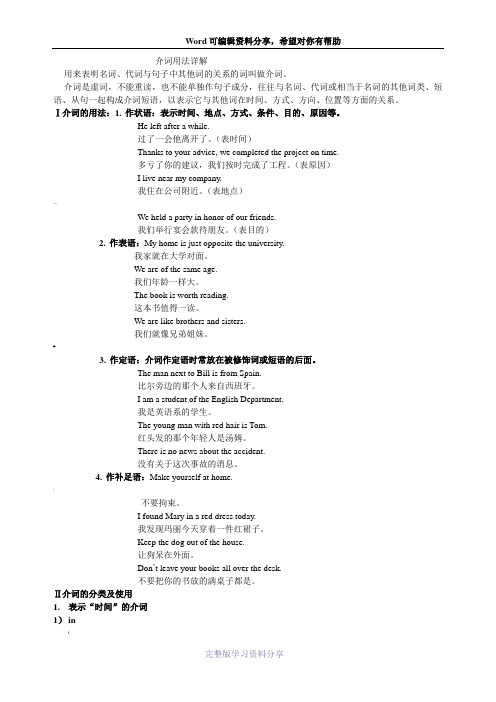
介词用法详解用来表明名词、代词与句子中其他词的关系的词叫做介词。
介词是虚词,不能重读,也不能单独作句子成分,往往与名词、代词或相当于名词的其他词类、短语、从句一起构成介词短语,以表示它与其他词在时间、方式、方向、位置等方面的关系。
Ⅰ介词的用法:1. 作状语:表示时间、地点、方式、条件、目的、原因等。
He left after a while.过了一会他离开了。
(表时间)Thanks to your advice, we completed the project on time.多亏了你的建议,我们按时完成了工程。
(表原因)I live near my company.我住在公司附近。
(表地点)—We held a party in honor of our friends.我们举行宴会款待朋友。
(表目的)2. 作表语:My home is just opposite the university.我家就在大学对面。
We are of the same age.我们年龄一样大。
The book is worth reading.这本书值得一读。
We are like brothers and sisters.我们就像兄弟姐妹。
#3. 作定语:介词作定语时常放在被修饰词或短语的后面。
The man next to Bill is from Spain.比尔旁边的那个人来自西班牙。
I am a student of the English Department.我是英语系的学生。
The young man with red hair is Tom.红头发的那个年轻人是汤姆。
There is no news about the accident.没有关于这次事故的消息。
4. 作补足语:Make yourself at home.\不要拘束。
I found Mary in a red dress today.我发现玛丽今天穿着一件红裙子。
介词用法详解掌握介词与其他词类的搭配规则
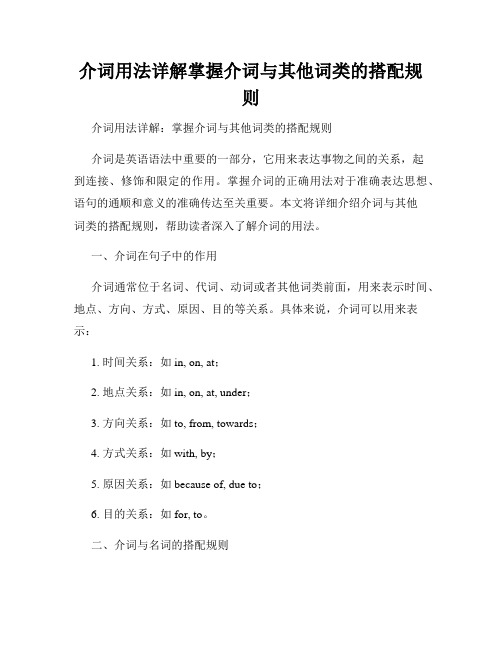
介词用法详解掌握介词与其他词类的搭配规则介词用法详解:掌握介词与其他词类的搭配规则介词是英语语法中重要的一部分,它用来表达事物之间的关系,起到连接、修饰和限定的作用。
掌握介词的正确用法对于准确表达思想、语句的通顺和意义的准确传达至关重要。
本文将详细介绍介词与其他词类的搭配规则,帮助读者深入了解介词的用法。
一、介词在句子中的作用介词通常位于名词、代词、动词或者其他词类前面,用来表示时间、地点、方向、方式、原因、目的等关系。
具体来说,介词可以用来表示:1. 时间关系:如in, on, at;2. 地点关系:如in, on, at, under;3. 方向关系:如to, from, towards;4. 方式关系:如with, by;5. 原因关系:如because of, due to;6. 目的关系:如for, to。
二、介词与名词的搭配规则介词与名词的搭配规则多种多样,我们来逐一介绍几个常见的搭配规则:1. 在特定日期或具体时间前使用介词on,如on Monday, on January 1st, on Christmas;2. 在年、月、季节等词后面使用介词in,如in 2022, in March, in summer;3. 在一天的具体时间前使用介词at,如at 9 o'clock, at noon, at midnight;4. 在表示地点的词后使用介词in、on或at,如in the park, on the table, at the cinema;5. 当名词表示某个范围时,使用介词in,如in the book, in the sky。
三、介词与代词的搭配规则介词与代词的搭配规则相对简单,我们来看几个常见的搭配规则:1. 使用介词to表示方向时,与代词he, she, it, they等连用,如go to school, give it to me;2. 使用介词for表示目的时,与代词us, you, them等连用,如buy a gift for us, prepare a meal for them;3. 当介词后面为代词时,需要使用宾格形式,如with me, for him。
介词with、without、of、by的用法详解
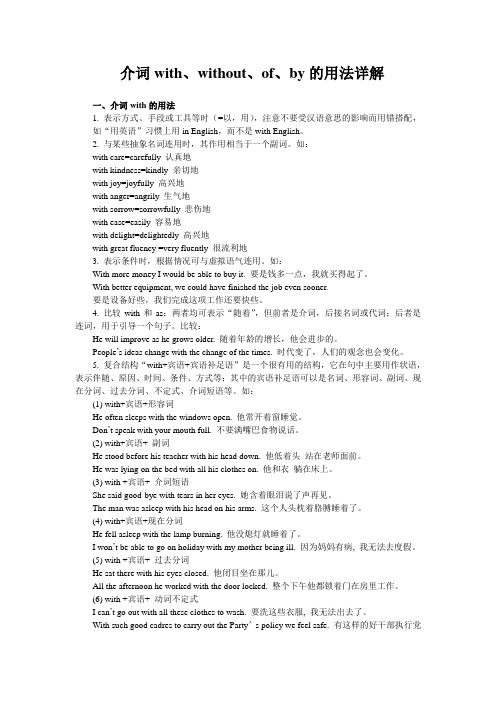
介词with、without、of、by的用法详解一、介词with的用法1. 表示方式、手段或工具等时(=以,用),注意不要受汉语意思的影响而用错搭配,如“用英语”习惯上用in English,而不是with English。
2. 与某些抽象名词连用时,其作用相当于一个副词。
如:with care=carefully 认真地with kindness=kindly 亲切地with joy=joyfully 高兴地with anger=angrily 生气地with sorrow=sorrowfully 悲伤地with ease=easily 容易地with delight=delightedly 高兴地with great fluency =very fluently 很流利地3. 表示条件时,根据情况可与虚拟语气连用。
如:With more money I would be able to buy it. 要是钱多一点,我就买得起了。
With better equipment, we could have finished the job even sooner.要是设备好些,我们完成这项工作还要快些。
4. 比较with和as:两者均可表示“随着”,但前者是介词,后接名词或代词;后者是连词,用于引导一个句子。
比较:He will improve as he grows older. 随着年龄的增长,他会进步的。
People’s ideas change with the change of the times. 时代变了,人们的观念也会变化。
5. 复合结构“with+宾语+宾语补足语”是一个很有用的结构,它在句中主要用作状语,表示伴随、原因、时间、条件、方式等;其中的宾语补足语可以是名词、形容词、副词、现在分词、过去分词、不定式、介词短语等。
如:(1) with+宾语+形容词He often sleeps with the windows open. 他常开着窗睡觉。
Unit 4 My Neighbourhood 知识点详解 (含答案)
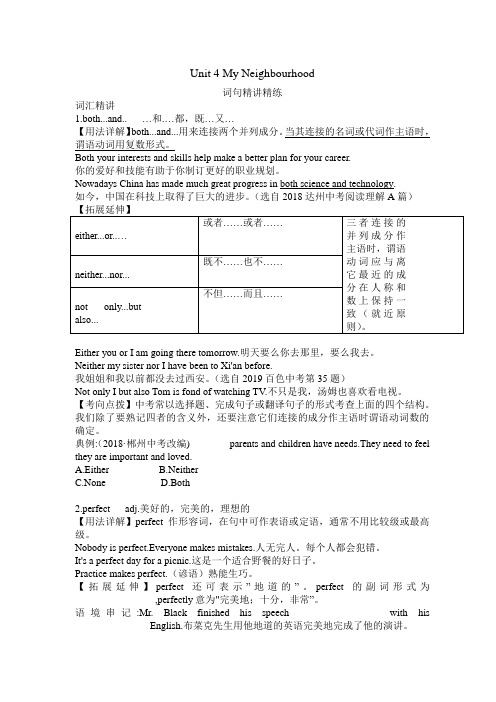
Unit 4 My Neighbourhood词句精讲精练词汇精讲1.both...and.. …和.…都,既…又…【用法详解】both...and...用来连接两个并列成分。
当其连接的名词或代词作主语时,谓语动词用复数形式。
Both your interests and skills help make a better plan for your career.你的爱好和技能有助于你制订更好的职业规划。
Nowadays China has made much great progress in both science and technology.如今,中国在科技上取得了巨大的进步。
(选自2018达州中考阅读理解A篇)Either you or I am going there tomorrow.明天要么你去那里,要么我去。
Neither my sister nor I have been to Xi'an before.我姐姐和我以前都没去过西安。
(选自2019百色中考第35题)Not only I but also Tom is fond of watching TV.不只是我,汤姆也喜欢看电视。
【考向点拨】中考常以选择题、完成句子或翻译句子的形式考查上面的四个结构。
我们除了要熟记四者的含义外,还要注意它们连接的成分作主语时谓语动词数的确定。
典例:(2018·郴州中考改编)________parents and children have needs.They need to feel they are important and loved.A.EitherB.NeitherC.NoneD.Both2.perfect adj.美好的,完美的,理想的【用法详解】perfect作形容词,在句中可作表语或定语,通常不用比较级或最高级。
Nobody is perfect.Everyone makes mistakes.人无完人。
介词by的用法
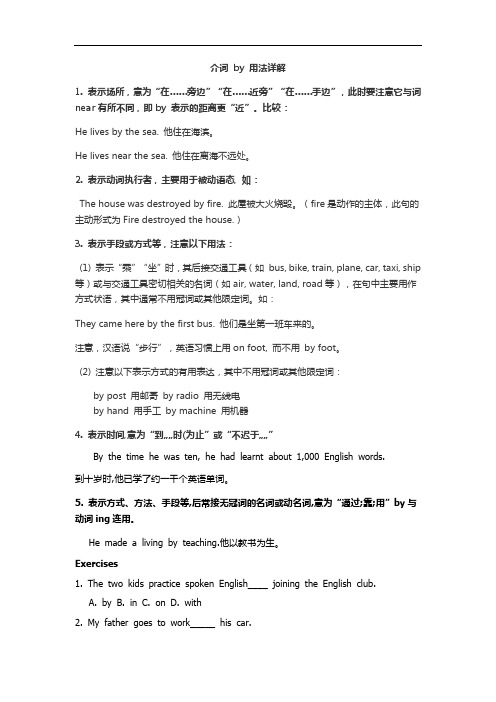
介词by 用法详解1. 表示场所,意为“在……旁边”“在……近旁”“在……手边”,此时要注意它与词near有所不同,即by 表示的距离更“近”。
比较:He lives by the sea. 他住在海滨。
He lives near the sea. 他住在离海不远处。
2. 表示动词执行者,主要用于被动语态, 如:The house was destroyed by fire. 此屋被大火烧毁。
(fire是动作的主体,此句的主动形式为Fire destroyed the house.)3. 表示手段或方式等,注意以下用法:(1) 表示“乘”“坐”时,其后接交通工具(如bus, bike, train, plane, car, taxi, ship 等)或与交通工具密切相关的名词(如air, water, land, road等),在句中主要用作方式状语,其中通常不用冠词或其他限定词。
如:They came here by the first bus. 他们是坐第一班车来的。
注意,汉语说“步行”,英语习惯上用on foot, 而不用by foot。
(2) 注意以下表示方式的有用表达,其中不用冠词或其他限定词:by post 用邮寄by radio 用无线电by hand 用手工by machine 用机器4. 表示时间,意为“到……时(为止”或“不迟于……”By the time he was ten, he had learnt about 1,000 English words.到十岁时,他已学了约一千个英语单词。
5. 表示方式、方法、手段等,后常接无冠词的名词或动名词,意为“通过;靠;用”by与动词ing连用。
He made a living by teaching.他以教书为生。
Exercises1. The two kids practice spoken English____ joining the English club.A. byB. inC. onD. with2. My father goes to work_____ his car.A. byB. inC. onD. at3. —_____ does her brother improve his English? —He improves it_____ asking the teacher for help.A.How, byB. What, withC. Why, inD. What, with4. We walk ___ our feet and we see ____our eyes. A, with, with B. in, in C. use, use D. by, by5. The rivers goes ___the forest.A. byB. inC. throughD. over。
考研英语语法 介词by of用法详解附译文
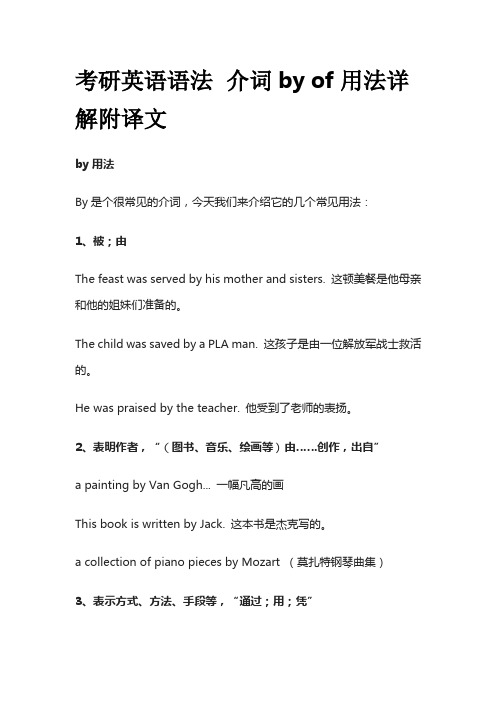
考研英语语法介词by of用法详解附译文by用法By是个很常见的介词,今天我们来介绍它的几个常见用法:1、被;由The feast was served by his mother and sisters. 这顿美餐是他母亲和他的姐妹们准备的。
The child was saved by a PLA man. 这孩子是由一位解放军战士救活的。
He was praised by the teacher. 他受到了老师的表扬。
2、表明作者,“(图书、音乐、绘画等)由……创作,出自”a painting by Van Gogh... 一幅凡高的画This book is written by Jack. 这本书是杰克写的。
a collection of piano pieces by Mozart (莫扎特钢琴曲集)3、表示方式、方法、手段等,“通过;用;凭”We'll be travelling by car. 我们将开车旅行。
They can read by touch. 他们可以通过手摸来阅读。
I send a letter by post. 我通过邮局寄信。
Make the sauce by boiling the cream and stock together in a pan. 把奶油和高汤一起放在平底锅里熬煮来制作调味料。
4、在…旁边;接近Judith was sitting in a rocking-chair by the window. 朱迪丝正坐在窗户边的一张摇椅里。
He gave me a story book when nobody was by. 当附近无人的时候他把小说给了我。
5、经过;经由He kept walking and passed by me on his side of the street. 他一直在街对面走着,并与街这边的我交错而过。
He hurried by without a word. 他匆匆地走过去没有说一句话。
英语by的用法归纳
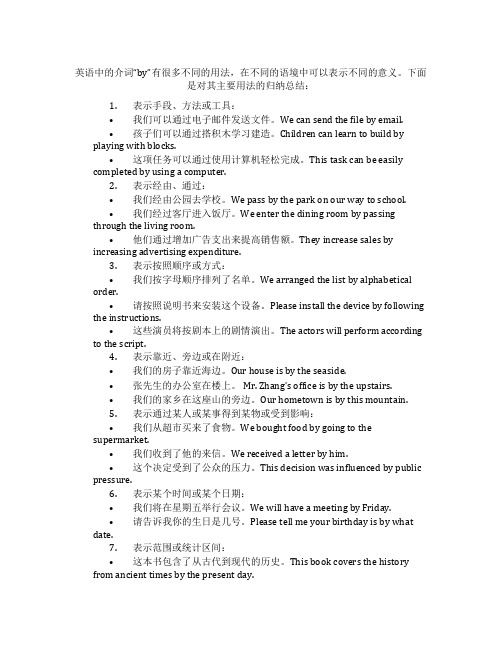
英语中的介词“by”有很多不同的用法,在不同的语境中可以表示不同的意义。
下面是对其主要用法的归纳总结:1.表示手段、方法或工具:•我们可以通过电子邮件发送文件。
We can send the file by email.•孩子们可以通过搭积木学习建造。
Children can learn to build by playing with blocks.•这项任务可以通过使用计算机轻松完成。
This task can be easily completed by using a computer.2.表示经由、通过:•我们经由公园去学校。
We pass by the park on our way to school.•我们经过客厅进入饭厅。
We enter the dining room by passing through the living room.•他们通过增加广告支出来提高销售额。
They increase sales by increasing advertising expenditure.3.表示按照顺序或方式:•我们按字母顺序排列了名单。
We arranged the list by alphabetical order.•请按照说明书来安装这个设备。
Please install the device by following the instructions.•这些演员将按剧本上的剧情演出。
The actors will perform according to the script.4.表示靠近、旁边或在附近:•我们的房子靠近海边。
Our house is by the seaside.•张先生的办公室在楼上。
Mr. Zhang’s office is by the upstair s.•我们的家乡在这座山的旁边。
Our hometown is by this mountain.5.表示通过某人或某事得到某物或受到影响:•我们从超市买来了食物。
by-the-time用法

By the time 用法详解•by the time意为“到……时候(为止)”,是一个介词短语,在句中经常起连词作用,引导时间状语从句。
它的主要用法如下:• 1. 如果从句中的谓语动词是一般过去时,那么主句中的谓语动词通常用过去完成时,表示“截止到从句动作发生时,主句动作已经完成,即过去的过去”。
例如:By the time he returned home,the rain had stopped.• By the time I got to the station,the train had already gone。
• 2. 如果从句中的谓语动词为一般现在时/或现在完成时(表示将来),那么主句中的谓语动词常为将来完成时,表示“截止到将来某一时间为止,主句动作将已经完成”。
By the time you get back,I shall have finished the work.• By the time I graduate next year, I will have lived here for 5 years. • By the time of next term , we will have learned 3000 words.• 3. 如果主句动作不强调已经完成,只是说明某个时候的状况,(主句是be的系表形式或者是表示像know, find, believe等表示认知的持续性动词,则往往用一般时态,不用完成时态。
)此时主句不用完成时,而应根据实际需要选用适当的时态,此时by the time相当于when。
例如:• He was out of breath by the time he reached the top.By the time the bus came,so many people were waiting that it was a free fight to get on it. 公共汽车来的时候,等车的人很多,成了一场挤车的混战。
(完整)by the time用法
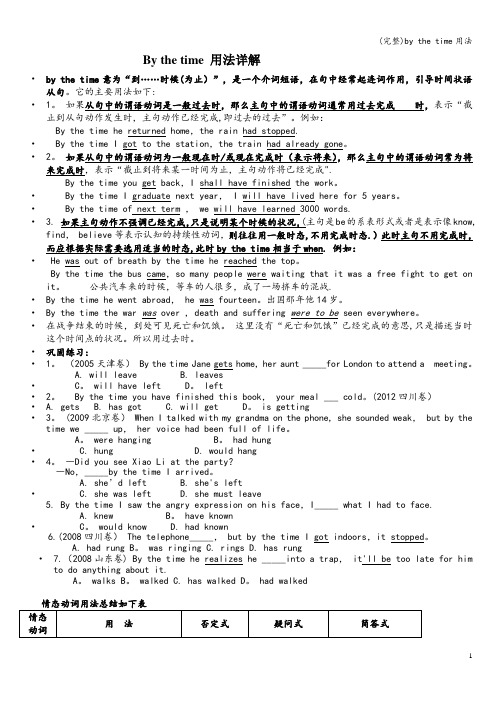
By the time 用法详解•by the time意为“到……时候(为止)”,是一个介词短语,在句中经常起连词作用,引导时间状语从句。
它的主要用法如下:•1。
如果从句中的谓语动词是一般过去时,那么主句中的谓语动词通常用过去完成时,表示“截止到从句动作发生时,主句动作已经完成,即过去的过去”。
例如:By the time he returned home,the rain had stopped.• By the time I got to the station,the train had already gone。
•2。
如果从句中的谓语动词为一般现在时/或现在完成时(表示将来),那么主句中的谓语动词常为将来完成时,表示“截止到将来某一时间为止,主句动作将已经完成".By the time you get back,I shall have finished the work。
• By the time I graduate next year, I will have lived here for 5 years。
• By the time of next term , we will have learned 3000 words.• 3. 如果主句动作不强调已经完成,只是说明某个时候的状况,(主句是be的系表形式或者是表示像know, find, believe等表示认知的持续性动词,则往往用一般时态,不用完成时态.)此时主句不用完成时,而应根据实际需要选用适当的时态,此时by the time相当于when. 例如:• He was out of breath by the time he reached the top。
By the time the bus came,so many people were waiting that it was a free fight to get on it。
介词offromforbyatduringbehind用法注意

介词 of 用法注意1. 表示所有关系,用以构成名词的所有格,如the the gate gate gate of of of the the the school school (校门),the the se se cret cret of of of success success (成功的秘密),等。
(成功的秘密),等。
注意以下正误表达:注意以下正误表达:正:He He is is is a a a friend friend friend of of of my my my father. father. 他是我父亲的一位朋友。
他是我父亲的一位朋友。
正:He He is is is a a a friend friend friend of of of my my my father’s. father’s. 他是我父亲的一位朋友。
他是我父亲的一位朋友。
正:He He is is is a a a friend friend friend of of of mine. mine. 他是我的一位朋友。
他是我的一位朋友。
误:He He is is is a a a friend friend friend of of of me.me. 以下表达是错误的:以下表达是错误的:误:What’s What’s the the the name name name of of of you?you?(改为…your your name name ) 误:Do Do you you you know know know the the the father father father of of of him?him?(改为…his his father father ) 误:I I will will will show show show the the the books books books of of of me.me.(改为…my my books books ) 但是以下表达却是对的(of 表示动宾关系):表示动宾关系):正:I I hate hate hate the the the sight sight sight of of of him. him. 我讨厌看到他。
- 1、下载文档前请自行甄别文档内容的完整性,平台不提供额外的编辑、内容补充、找答案等附加服务。
- 2、"仅部分预览"的文档,不可在线预览部分如存在完整性等问题,可反馈申请退款(可完整预览的文档不适用该条件!)。
- 3、如文档侵犯您的权益,请联系客服反馈,我们会尽快为您处理(人工客服工作时间:9:00-18:30)。
介词by用法详解
1.表示场所,意为“在……旁边”“在……近旁”“在……手边”,此时要注意它与介词near有所不同,即by 表示的距离更“近”。
比较:
He lives by the sea. 他住在海滨。
He lives near the sea. 他住在离海不远处。
2.表示动词执行者,主要用于被动语态,此时要注意它与介词with的区别:by 表示动作的主体,with 表示动作者的手段工具。
如:
The house was destroyed by fire. 此屋被大火烧毁。
(fire是动作的主体,此句的主动形式为Fire destroyed the house.)
The house was destroyed with fire. 此屋是(被人)用火烧毁的。
(fire只是工具,动作的主体另有其人,此句可认为省略了一个by短语,如by someone之类的,其主动形式可以是Someone destroyed the house with fire.)
3.表示手段或方式等,注意以下用法:
(1) 表示“乘”“坐”时,其后接交通工具(如bus, bike, train, plane, car, taxi, ship 等)或与交通工具密切相关的名词(如air, water, land, road等),在句中主要用作方式状语,其中通常不用冠词或其他限定词。
如:
They came here by the first bus. 他们是坐第一班车来的。
但是,若表示交通工具的名词前插有定语修饰语,则也可以用冠词。
如:
We’re going by the 9:30 train. 我们坐9:30的火车去。
We went to Shanghai by a large ship. 我们乘一艘大船去上海。
注意,汉语说“步行”,英语习惯上用on foot, 而不用by foot。
(2) 注意以下表示方式的有用表达,其中不用冠词或其他限定词:
by phone 用电话by telegram 用电报
by letter 用信件by express 用快件
by air mail 用航空邮件by ordinary mail 用平信
by post 用邮寄by radio 用无线电
by hand 用手工by machine 用机器
注意下面两例用by与用with的区别:
The letter was written by hand. 这封信是用手写的(即不是打印的)。
(by hand表示一种抽象的手段,是无形的,注意其中没用冠词或其他限定词)
I write with my hand, but he writes with his mouth. 我用手写字,但他却用嘴写字。
(with one’s hand表示一种具体的工具,是有形的,注意其中用了物主代词)
(3) 后接动名词表示行为的方式或手段,这是一种常用表达。
如:
He makes a living by teaching. 他以教书为生。
Lock this door by turning the key twice to the left. 锁这扇门要把钥匙向左转两圈。
4.表示抓或握的部位,注意以下用法。
如:
(1) 表示抓住或握住某人或某物的某一部位, 其中这个人或物应是前面已提到过的,且在介词by 之后通常用定冠词the 而不用物主代词。
如:
She held the child by the hand. 她抓住小孩的手。
He grabbed the knife by the blade. 他抓住刀刃。
He led the ox by the nose. 他牵着牛的鼻子走。
(2) 有时也可以直接用人的部位作“抓”或“握”的宾语, 但强调重点不同:若以人作宾语,后接by短语,强调动作的直接目的在于人,by短语只是说明动作的方式;若以人的部位作宾语,则强调动作的直接目的在于部位而不在于人。
比如:当我们抓住坏人时,我们可以说I seized the man by the hand. 因为这时动作的直接目的在于抓人,只是以by the hand
作为抓的方式。
但是当我们要同客人握手时,则通常说I seized his hand and shook it hea rtily. 因为这里动作直接目的是要握手,而不是抓人,此时若说I seized him and shook hi s hand. 就很奇怪了。
(顺便说一句,与某人握手用shake hands with, shake one’s hand, s hake sb by the hand 均可)
5.表示时间,指“最迟在……之前”“到……的时候已经”,此时要注意它所连用的时态。
如:
He was very tired by the evening. 他到晚上已经很累了。
He has read about 40 pages of the book by now. 现在这本书他已读了大约40页。
We will have finished the work by next month. 到下个月我们就会干完了这工作。
By the time the doctor arrived the patient had died. 在医生到达时,病人已经死了。
另外,表示时间时,它还可表示“在……期间”,通常连用的名词是day, night, moonli ght, daylight等,注意名词前通常不用冠词。
如:
Cats sleep by day and hunt by night. 猫白天睡觉,夜里捉老鼠。
Do you like to swim by moonlight? 你喜欢在月光下游泳吗?
6.表示单位,意为“以……计”,其后通常接表示计量单位的单数名词,且名词前要用定冠词。
如:
They are paid by the hour (by the month). 他们所得报酬按小时(月)计。
Milk is sold by the pint, butter by the pound, and eggs by the dozen. 牛奶按品脱卖,黄油论磅卖,蛋类论打卖。
有时也接抽象名词,此时通常不用冠词。
如:
Bananas are usually sold by weight. 香蕉通常按重量卖。
